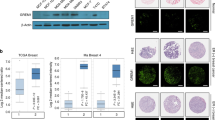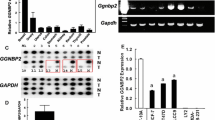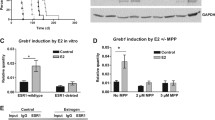Summary
Background Estrogen plays a central role in breast cancer pathogenesis and many potent risk factors for the development of the disease can be explained in terms of increased lifetime exposure to estrogen. Although estrogen regulated genes have been identified, those critically involved in growth regulation remain elusive.
Methods. To identify candidate genes involved in estrogen stimulated breast cancer growth, DNA microarray based gene expression profiles were generated from three estrogen receptor α (ERα) positive breast cancer cell lines grown under multiple stimulatory and inhibitory conditions.
Results Only three genes were significantly induced by 17β-estradiol (E2) relative to control in all three cell lines: GREB1, stromal cell-derived factor 1 (SDF-1) and trefoil factor 1 (pS2). Quantitative real-time PCR assays confirmed that in all three cell lines, GREB1 was induced by E2, but not by the antiestrogens tamoxifen (TAM) or ICI 182,780. GREB1 expression level was strongly correlated with ERα positivity in 39 breast cancer cell lines of known ERα expression status. GREB1 induction by E2 was rapid (7.3 fold by 2 h for MCF-7) and mirrored the fraction of cells entering S-phase when released from an estrogen deprivation induced cell arrest. Suppression of GREB1 using siRNA blocked estrogen induced growth in MCF-7 cells and caused a paradoxical E2 induced growth inhibition.
Conclusion These data suggest that GREB1 is critically involved in the estrogen induced growth of breast cancer cells and has the potential of being a clinical marker for response to endocrine therapy as well as a potential therapeutic target.
Similar content being viewed by others
Abbreviations
- E2:
-
17β-estradiol
- ERα:
-
estrogen receptor alpha
- ERβ:
-
estrogen receptor beta
- FBS:
-
fetal bovine serum
- GREB1:
-
gene regulated in breast cancer 1
- pS2:
-
trefoil factor 1
- SDF-1:
-
stromal cell-derived factor 1
References
American Cancer Society. Cancer Facts and Figures 2004, 2004.
RM Elledge SA Fuqua (2000) Estrogen and progesterone receptors J Harris ME Lippman M Morrow C Osborne (Eds) Diseases of the Breast Lippincott, Williams and Wilkins Philadelphia 471–488
VC Jordan (2003) ArticleTitleTamoxifen: a most unlikely pioneering medicine Nat Rev Drug Discov 2 IssueID3 205–213
DP McDonnell JD Norris (2002) ArticleTitleConnections and regulation of the human estrogen receptor Science 296 IssueID5573 1642–1644
MD Johnson H Zuo KH Lee JP Trebley JM Rae RV Weatherman Z Desta DA Flockhart TC Skaar (2004) ArticleTitlePharmacological characterization of 4-hydroxy-N-desmethyl tamoxifen, a novel active metabolite of tamoxifen Breast Cancer Res Treat 85 IssueID2 151–159
JM Rae ME Lippman (2004) ArticleTitleEvaluation of novel epidermal growth factor receptor tyrosine kinase inhibitors Breast Cancer Res Treat 83 IssueID2 99–107
C Li WH Wong (2001) ArticleTitleModel-based analysis of oligonucleotide arrays: expression index computation and outlier detection Proc Natl Acad Sci USA 98 IssueID1 31–36
AJ Bosma B Weigelt AC Lambrechts OJ Verhagen R Pruntel AA Hart S Rodenhuis VJ van’t Veer (2002) ArticleTitleDetection of circulating breast tumor cells by differential expression of marker genes Clin Cancer Res 8 IssueID6 1871–1877
J Laborda (1991) ArticleTitle36B4 cDNA used as an estradiol-independent mRNA control is the cDNA for human acidic ribosomal phosphoprotein PO Nucleic Acids Res 19 IssueID14 3998
KJ Livak TD Schmittgen (2001) ArticleTitleAnalysis of relative gene expression data using real-time quantitative PCR and the 2(–Delta Delta C(T)) Method Methods 25 IssueID4 402–408
R Clarke N Brunner D Katz P Glanz RB Dickson ME Lippman FG Kern (1989) ArticleTitleThe effects of a constitutive expression of transforming growth factor-α on the growth of MCF-7 human breast cancer cells in vitro and in vivo Mol Endocrinol 3 IssueID2 372–380
P Workman A Balmain JA Hickman NJ McNally AM Rohas NA Mitchison CF Pierrepoint R Raymond C Rowlatt TC Stephens (1988) ArticleTitleUKCCCR guidelines for the welfare of animals in experimental neoplasia Lab Anim 22 IssueID3 195–201
O Lefebvre MP Chenard R Masson J Linares A Dierich M LeMeur C Wendling C Tomasetto P Chambon MC Rio (1996) ArticleTitleGastric mucosa abnormalities and tumorigenesis in mice lacking the pS2 trefoil protein Science 274 IssueID5285 259–262
JM Hall KS Korach (2003) ArticleTitleStromal cell-derived factor 1, a novel target of estrogen receptor action, mediates the mitogenic effects of estradiol in ovarian and breast cancer cells Mol Endocrinol 17 IssueID5 792–803
MG Ghosh DA Thompson RJ Weigel (2000) ArticleTitlePDZK1 and GREB1 are estrogen-regulated genes expressed in hormone-responsive breast cancer Cancer Res 60 IssueID22 6367–6375
M Lacroix G Leclercq (2004) ArticleTitleRelevance of breast cancer cell lines as models for breast tumours: an update Breast Cancer Res Treat 83 IssueID3 249–289
M Soulez MG Parker (2001) ArticleTitleIdentification of novel oestrogen receptor target genes in human ZR75–1 breast cancer cells by expression profiling J Mol Endocrinol 27 IssueID3 259–274
A Inoue N Yoshida Y Omoto S Oguchi T Yamori R Kiyama S Hayashi (2002) ArticleTitleDevelopment of cDNA microarray for expression profiling of estrogen-responsive genes J Mol Endocrinol 29 IssueID2 175–192
J Frasor JM Danes B Komm KC Chang CR Lyttle BS Katzenellenbogen (2003) ArticleTitleProfiling of estrogen up- and down-regulated gene expression in human breast cancer cells: insights into gene networks and pathways underlying estrogenic control of proliferation and cell phenotype Endocrinology 144 IssueID10 4562–4574
J Frasor F Stossi JM Danes B Komm CR Lyttle BS Katzenellenbogen (2004) ArticleTitleSelective estrogen receptor modulators: discrimination of agonistic versus antagonistic activities by gene expression profiling in breast cancer cells Cancer Res 64 IssueID4 1522–1533
DY Wang R Fulthorpe SN Liss EA Edwards (2004) ArticleTitleIdentification of estrogen-responsive genes by complementary deoxyribonucleic acid microarray and characterization of a novel early estrogen-induced gene: EEIG1 Mol Endocrinol 18 IssueID2 402–411
Stossi F, Barnett DH, Frasor J, Komm B, Lyttle CR, Katzenellenbogen BS: Transcriptional profiling of estrogen-regulated gene expression via estrogen receptor α or estrogen receptor β in human osteosarcoma cells: distinct and common target genes for these receptors**. Endocrinology 2004
AM Brown JM Jeltsch M Roberts P Chambon (1984) ArticleTitleActivation of pS2 gene transcription is a primary response to estrogen in the human breast cancer cell line MCF-7 Proc Natl Acad Sci USA 81 IssueID20 6344–6348
JA Foekens H Portengen MP Look WL Putten Particlevan B Thirion M Bontenbal JG Klijn (1994) ArticleTitleRelationship of PS2 with response to tamoxifen therapy in patients with recurrent breast cancer Br J Cancer 70 IssueID6 1217–1223
JA Henry NH Piggott UK Mallick S Nicholson JR Farndon BR Westley et al. (1991) ArticleTitlepNR-2/pS2 immunohistochemical staining in breast cancer: correlation with prognostic factors and endocrine response Br J Cancer 63 IssueID4 615–622
E Oberlin A Amara F Bachelerie C Bessia JL Virelizier F Arenzana-Seisdedos O Schwartz JM Heard I Clark-Lewis DF Legler M Loetscher M Baggiolini B Moser (1996) ArticleTitleThe CXC chemokine SDF-1 is the ligand for LESTR/fusin and prevents infection by T-cell-line-adapted HIV-1 Nature 382 IssueID6594 833–835
A Muller B Homey H Soto N Ge D Catron ME Buchanan T McClanahan E Murphy W Yuan SN Wagner JL Barrera A Mohar E Verastegui A Zlotnik (2001) ArticleTitleInvolvement of chemokine receptors in breast cancer metastasis Nature 410 IssueID6824 50–56
T Nagase K Ishikawa N Miyajima A Tanaka H Kotani N Nomura O Ohara (1998) ArticleTitlePrediction of the coding sequences of unidentified human genes. IX. The complete sequences of 100 new cDNA clones from brain which can code for large proteins in vitro DNA Res 5 IssueID1 31–39
M Peterfy J Phan GM Oswell P Xu K Reue (1999) ArticleTitleGenetic, physical, and transcript map of the fld region on mouse chromosome 12 Genomics 62 IssueID3 436–444
CY Lin A Strom VB Vega SL Kong AL Yeo JS Thomsen WC Chan B Doray DK Bangarusamy A Ramasamy LA Vergara S Tang A Chong VB Bajic LD Miller JA Gustafsson ET Liu (2004) ArticleTitleDiscovery of estrogen receptor alpha target genes and response elements in breast tumor cells Genome Biol 5 IssueID9 R66
JT Chi HY Chang NN Wang DS Chang N Dunphy PO Brown (2003) ArticleTitleGenomewide view of gene silencing by small interfering RNAs Proc Natl Acad Sci USA 100 IssueID11 6343–6346
Author information
Authors and Affiliations
Corresponding author
Rights and permissions
About this article
Cite this article
Rae, J.M., Johnson, M.D., Scheys, J.O. et al. GREB1 is a critical regulator of hormone dependent breast cancer growth. Breast Cancer Res Treat 92, 141–149 (2005). https://doi.org/10.1007/s10549-005-1483-4
Issue Date:
DOI: https://doi.org/10.1007/s10549-005-1483-4




